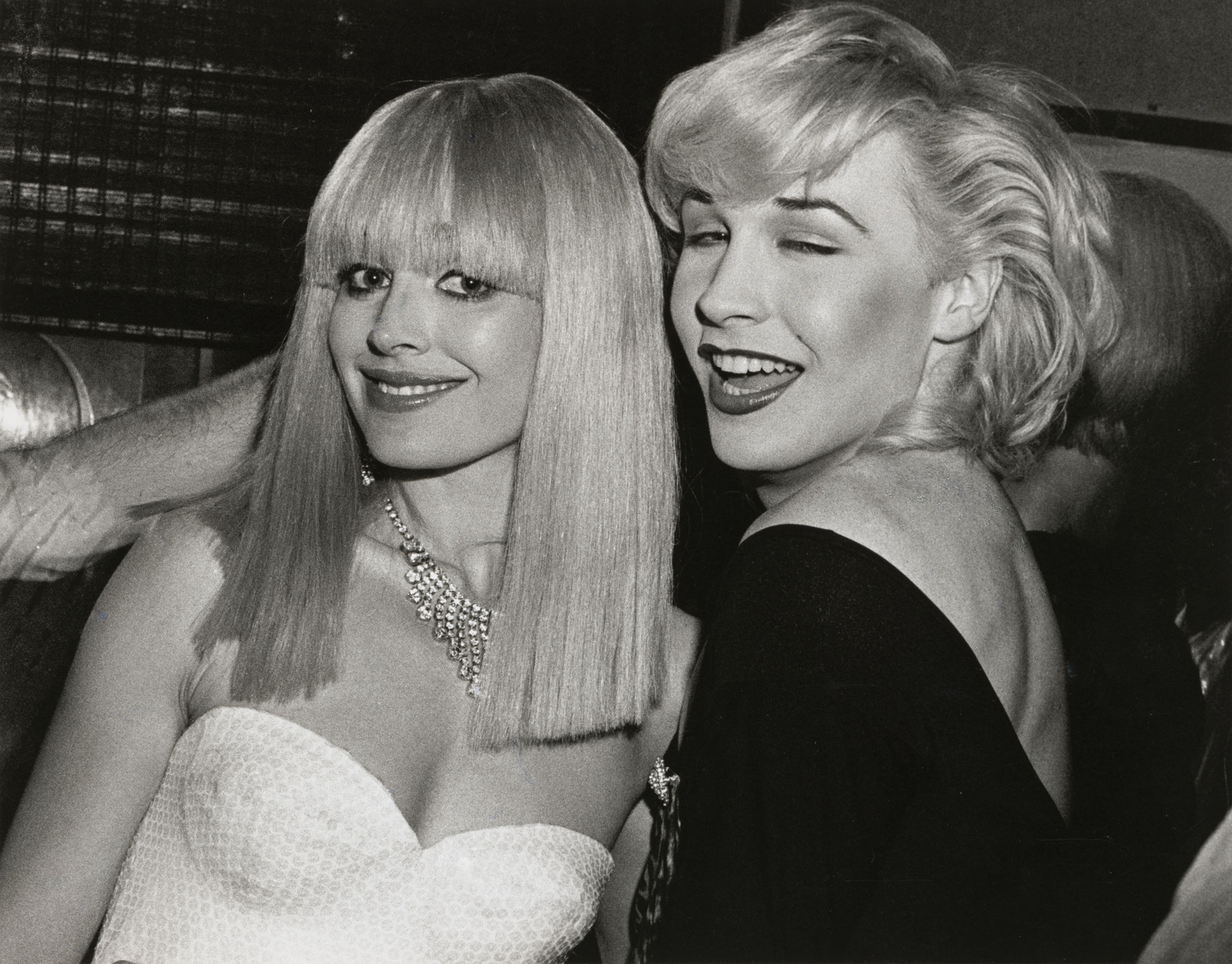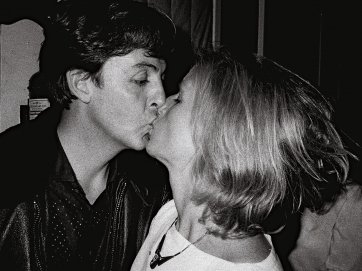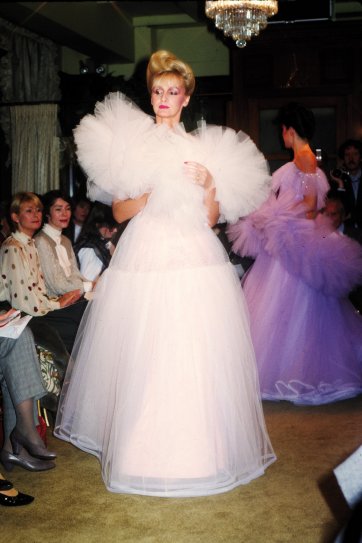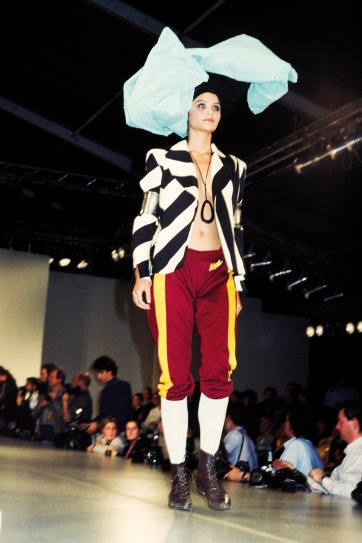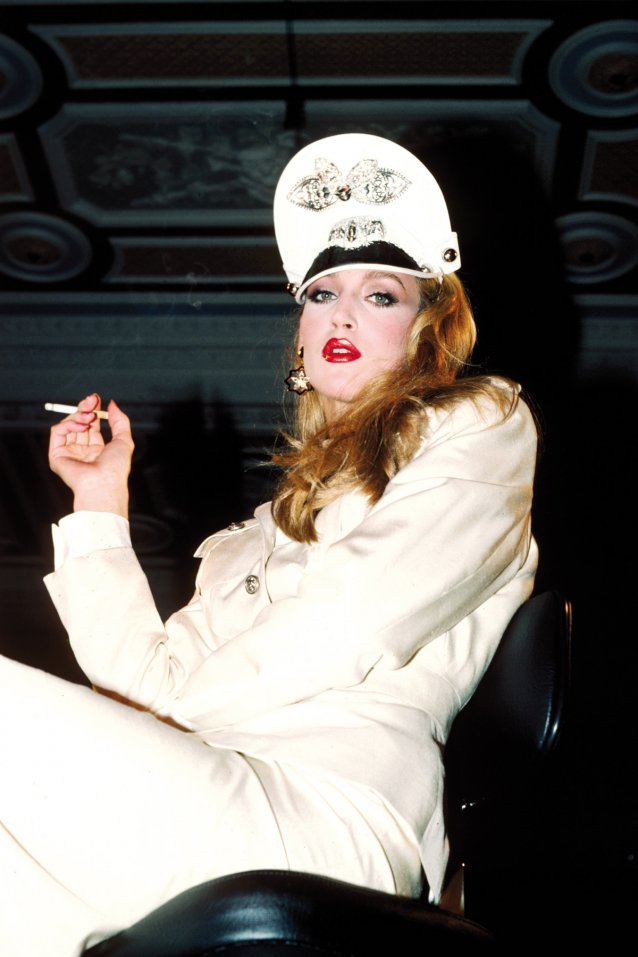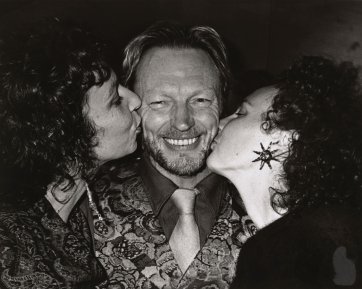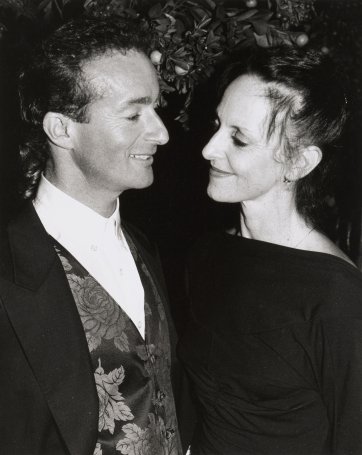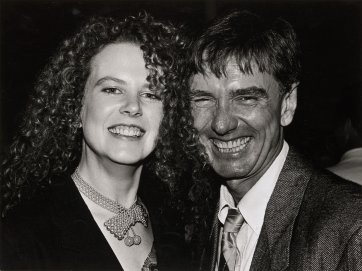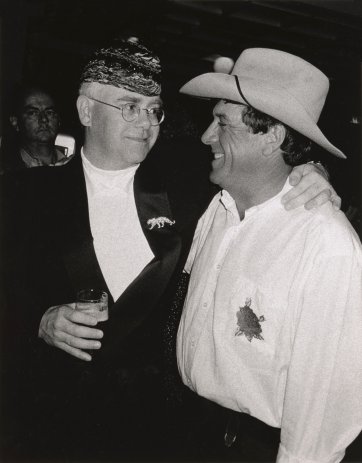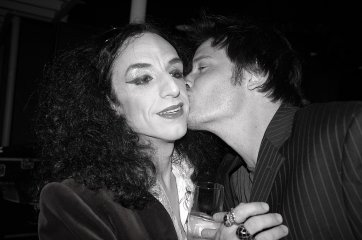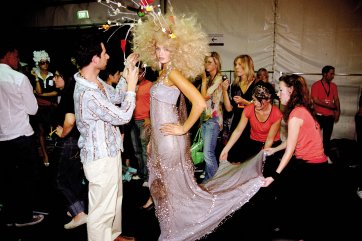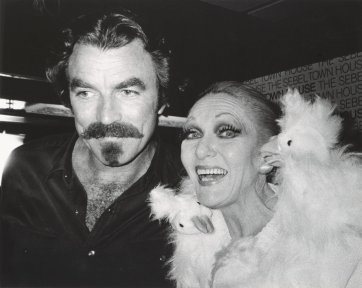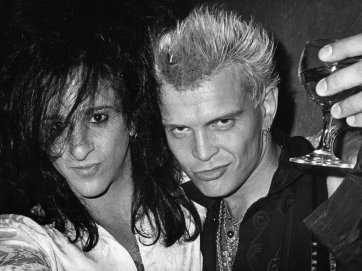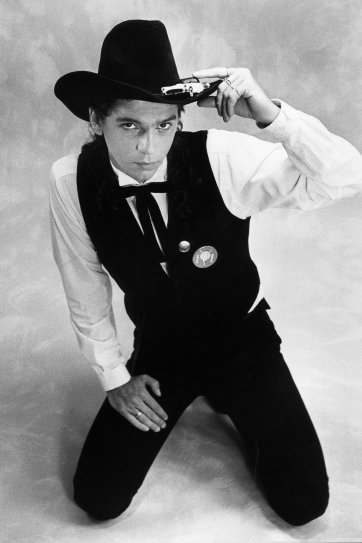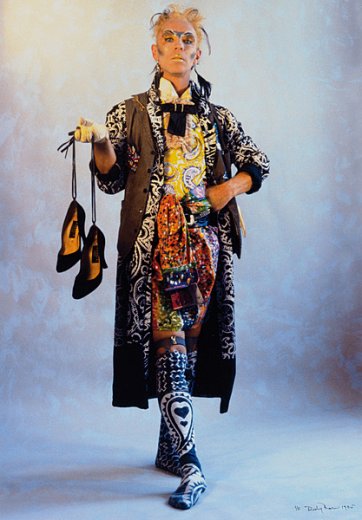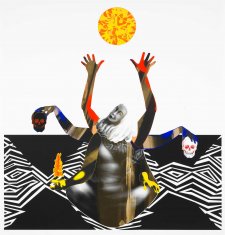Lyndall Hobbs and Marilyn at the Come as your favourite blonde party, Blitz Club, London, 1979 Robert Rosen. © Robert Rosen. Collection Museum of Applied Arts and Sciences, Sydney
For over four decades from the late 1970s, Robert Rosen attended glittering parties, concerts, product launches, fashion events and nightclubs across London, Paris, Sydney and Melbourne, documenting society, celebrities and fashion for the pages of Australian and international newspapers and magazines. His work can be considered part of a long history of social documentary that both responds to and encourages the public’s fascination with images of fame and fashion.
Rosen has remarked that he always felt it was his ‘destiny to shoot stars and celebrities’. Born in Cape Town, South Africa, his family moved to Melbourne in 1960 and from childhood Rosen saved his pocket money to buy magazines filled with photos of glamorous film stars and celebrities, which he mounted on his bedroom walls. His formative years highlight the significant part an astute and open-minded teacher or mentor can play in nurturing a creative life. Enjoying the art course at Melbourne High School, Rosen determined to become an artist but recalls his art teacher’s observation that painting was not the best medium for his artistic expression: ‘Roy Irvine told me I would never be a painter and handed me a SLR Pentax 35mm camera and said, “Try this”. Well, I never looked back!’ At Prahran Technical College, celebrated photographer Athol Shmith and filmmaker Paul Cox supported Rosen’s art-based approach to photography in the face of increasing pressure from teaching staff to present more commercially focused work.
1 Boy George at the Embassy Club, London, 1979. 2 Paul and Linda McCartney, Abbey Road Studios, London, 1982. Both Robert Rosen.
© Robert Rosen Robert Rosen collection
By the mid-1970s Rosen was following the long trail of Australian creatives to London seeking more stimulating and vibrant cultural opportunities. Joining a share house with Richard Sharah, the talented Lebanese-Australian makeup artist who helped shape the visual identity of Zandra Rhodes and David Bowie, he was introduced to an exciting new world of fashion designers and models, moving into a social whirl of fabulous parties, restaurants and clubs. Observing the photographers attending these events Rosen discovered they were selling their celebrity snaps to magazines, a revelation that prompted his move into social photography. His unassuming approach and quirky personal style helped him establish a rapport that is reflected in his images of the charismatic cast of characters attending London’s burgeoning nightclubs and parties. Some, like Peter Robinson, a style maverick who changed his name to Marilyn and transformed his look to 1950s glamour, presented a striking visual presence both familiar and provocative. Of more enduring fame, it was George O’Dowd, better known as Boy George, whose style and career helped define the period's diverse musical, sexual and sartorial freedoms. Rosen was quick to recognise Boy George as a style leader, capturing him dressed in a Boudica-inspired headdress, looking spectacular despite living in a squat and working as the hat check boy at Blitz Club – before fame and Culture Club changed his life.
Rosen’s images appeared in the pages of emerging avant-garde media such as the Ritz newspaper as well as mainstream press the Express, Daily Mail and the Evening Standard. With the images presented gridded together on the page, jostling for attention, it was important for Rosen to closely frame his subjects, making the setting indeterminate but the faces quickly recognisable and the performance of character impactful.
Establishing a busy practice where the boundaries between life and work blurred, Rosen segued seamlessly between the role of guest and photographer. His camera of choice – Canon’s recently introduced lightweight, pocket-sized auto-focus camera – suited the spontaneous and fleeting nature of social photography, aiding his ability to juggle a glass of champagne in one hand and snap with the other.
London’s nightclubs became workplace and office for Rosen, who picked up most of his assignments through the editors and public relations agents socialising there. This included influential PR agent Lynne Franks, who in the early 1980s represented some of Europe’s most innovative young designers and was also instrumental in the foundation of London Fashion Week. Franks paved Rosen’s way into the exclusive, by invitation, seasonal London and Paris fashion shows.
From his position beside the runway, Rosen documented the latest ready-to-wear styles presented by established and emerging designers. Before the proliferation of new digital technologies and media platforms, fashion magazines played a leading role as tastemakers, using runway reportage to disseminate news of the latest trends and fueling consumer desire for styles and labels that would be available in retail outlets several months later.
1 Murray Arbeid Spring/Summer 1982 collection, London, 1982. © Robert Rosen. Collection Museum of Applied Arts and Sciences, Sydney. 2 John Galliano modelled by Helena Christensen, Spring/Summer 1990 collection, Paris, 1990. © Robert Rosen. Collection Museum of Applied Arts and Sciences, Sydney. Both Robert Rosen.
Over ten years Rosen captured the diversity of runway looks, including the influence of street and club cultures introduced by a new generation of designers like John Galliano and Vivienne Westwood. The romantic nostalgia of the dress that Diana, Princess of Wales wore on her wedding day was one of the most enduring influences, inspiring a decade of voluminous evening and wedding dresses.
Jerry Hall models Antony Price Spring/Summer 1981 collection, London, 1981 Robert Rosen. © Robert Rosen. Collection Museum of Applied Arts and Sciences, Sydney
At a time when smoking was considered cool and glamorous, Rosen’s 1981 portrait of Jerry Hall, taken during the collection show of English designer Antony Price, portrays a model at the height of her career. Her outfit’s camp edge reflects Price’s interest in the fetishised uniforms featured in the homoerotic drawings of Finnish artist Touko Laaksonen (Tom of Finland).
1 Andrew Logan and Divine at the Alternative Miss World premiere screening, London, 1980. 2 Anna Volska, John and Hilary Bell at his opening night, Belvoir Street Theatre, Sydney, 1990. Both Robert Rosen.
© Robert Rosen Collection Museum of Applied Arts and Sciences, Sydney
Having honed his photography skills in London, and reluctant to endure another cold European winter, Rosen was enticed back to Sydney in the mid-1980s and began shooting fashion and social pages for Harper’s Bazaar Australia, Mode magazine and Vogue Australia. Mainstream newspapers were also increasing their reportage of social events and Rosen worked closely with Dorian Wild, society columnist at the Daily Telegraph. The 1980s in Australia have been characterised as a time of prosperity, glamour, frivolity and excess and certainly Rosen has described the party scene as a test of endurance. ’We had to find stories every night to be published almost immediately,’ he recalled. ‘We’d go racing around from one event to the next trying to get the ultimate shot for the paper.’ It was a flourishing time in the arts and Rosen’s lens captured many of those involved in the emerging expression of an Australian identity across music, dance, fashion, film, television, design and art. Armed with his ‘snappy’ camera and rolls of 36-frame Kodak ASA 400 black-and-white film, suited to the low light levels of evening events, he was often seen draped in two or three cameras, earning him the nickname Robert ‘Twogun’ Rosen.
1 Graeme Murphy and Janet Vernon at the Sydney Dance Company party, Regent Hotel, Sydney, 1991. © Robert Rosen. Collection Museum of Applied Arts and Sciences, Sydney. 2 Nicole Kidman and John Hargreaves at the Emerald City film premiere, State Theatre, Sydney, 1988. © Robert Rosen. Collection Museum of Applied Arts and Sciences, Sydney. 3 Rory O’Donoghue and Grahame Bond at the APRA Awards, Sydney, 1988. © Robert Rosen. Collection Museum of Applied Arts and Sciences, Sydney. 4 Sir Elton John and Ian ‘Molly’ Meldrum at the Sebel Town House, Sydney, 1990. © Robert Rosen. Collection Museum of Applied Arts and Sciences, Sydney. All Robert Rosen.
The potency and appeal of Rosen’s images comes from the easy interaction and trust between photographer and subject. He had to work quickly, moving through the crowd selecting his subjects. Not having the luxury of time to stage a portrait Rosen often kindled a narrative by shooting people in pairs, a coupling that prompted the subjects to perform together, allowing him to capture their relational dynamic – from the intense look of love between dancers and choreographers Graeme Murphy and Janet Vernon and the relaxed ease of Elton John’s friendship with Ian ‘Molly’ Meldrum to Graham Bond and Rory O’Donoghue’s cheeky performance to camera and the excitement on the faces of Nicole Kidman and John Hargreaves at the premiere party of their film Emerald City.
1 Paul Capsis and Aden Young at the Armani Sydney Theatre Company Dinner, Sydney, 2007. © Robert Rosen. Robert Rosen collection. 2 Julian McMahon and Virginia Hey at DV8 Dance Party, Sydney, 1989. © Robert Rosen. Collection Museum of Applied Arts and Sciences, Sydney. Both Robert Rosen.
There was anticipation, and some scepticism, when Simon P. Lock presented Australia’s inaugural fashion week in May 1996. Held at Sydney’s Fox Studios, it was the first time Australian designers had presented their work together in a week of collection shows, staged before an audience of local and international press, buyers and celebrities. Despite the local industry struggling in the wake of lowered import tariffs and competition from overseas, Lock’s ambitious vision was to see Sydney join Milan, Paris, London, New York and Tokyo as part of the international fashion circuit. Fashion editor Jackie Frank had recently launched Marie Claire Australia and, aiming for a fresh perspective on fashion reportage, commissioned Rosen to shoot the event from backstage. For the next fifteen years this was to be his favoured viewpoint. ‘There was so much happening and as the tension and excitement escalated toward the opening of each show, the better the shots,’ he said. Rosen’s images capture the significant ‘coming of age’ of the local fashion industry and reveal the many talented individuals – hair and makeup artists, show producers, stylists, choreographers and dressers – working behind the scenes to create a successful fashion show.
1 Linda Evangelista backstage modelling for the Alex Perry Spring/Summer 1997–98 show, Mercedes Australian Fashion Week, Sydney, 1997. 2 Backstage preparing for the Leona Edmiston Spring/Summer 2005–06 show, Mercedes Australian Fashion Week, Sydney, 2005. Both Robert Rosen.
© Robert Rosen Collection Museum of Applied Arts and Sciences, Sydney
Despite the cost, securing an international supermodel to walk in a runway show quickly elevates attention around a designer’s work, ensuring prominent and extensive coverage by the media. Rosen’s relaxed and smiling image of Canadian supermodel Linda Evangelista in Alex Perry’s billowing ballgown belies the backstage drama. Rosen recalled the model acting like a diva: ‘she kept the audience waiting over an hour in sweltering heat. Backstage tension was rising as we could hear slow hand clapping starting up from the audience.’ Despite the delay, Evangelista’s image provided Alex Perry with one of Australian Fashion Week’s enduring iconic moments.
1 Tom Sellick and Jeanne Little at the Sebel Townhouse, Sydney, 1989. © Robert Rosen. Collection Museum of Applied Arts and Sciences, Sydney. 2 Steve Stevens and Billy Idol, Sydney, 1987. © Robert Rosen. Robert Rosen collection. Both Robert Rosen.
While much of Rosen’s commercial work involved capturing spontaneous and fleeting moments on the runway, an event or performance, he has always practised the slower, more intimate form of staged portrait photography. For Harper’s Bazaar Australia Rosen created a portrait series featuring Sydney personalities dressed in their favourite clothes.
Cabaret artist, actor, make-up artist and designer Simon Reptile (Simon McDowell) was both the stylist and star of this project, in which Rosen captured his unconventional personality and style. The muted palette and subtlety found in the dress of the 19th-century dandy is here redefined through the loud clash of colour, pattern and motif, exposed garters, inversion of coat and waistcoat and the carefully coiffed but wildly patterned hair and makeup. Through his choice of wardrobe Reptile championed the work of Australian designers, making a feature of Kathy McKinnon’s paisley coat, Sarah Thorn’s T-shirt and Les Bean’s hand painted shirt, here worn as a skirt.
1 Michael Hutchence, portrait for Harper’s Bazaar Australia, Rosemount Avenue Studio, Sydney, 1985. © Robert Rosen. Robert Rosen collection. 2 Simon Reptile, Rosemount Avenue Studio, Sydney, 1985. © Robert Rosen. Collection Museum of Applied Arts and Sciences, Sydney. Both Robert Rosen.
The series also included Michael Hutchence, who Rosen first met at a party in 1985, and embarrassingly didn’t recognise. ‘I said “Oh my god, if I meet another singer or model in Sydney I am going to scream!”’ He took this image a few months later. ‘I did many photos of Michael over the years but this portrait is my favourite. It shows his strength of character and warmth at the same time. Wearing a hat he swapped for a bottle of Jim Beam in Arizona (worn by Clint Eastwood in a movie) he holds up a small toy car a fan threw onstage.’
Rosen retired to Seminyak in 2012 and, recognising the potentially damaging effect of Bali’s tropical climate on his archive, donated his extensive collection of negatives, prints, transparencies, tear sheets, diaries, press passes and invitations to the Powerhouse. This archive now forms the basis for the first major retrospective of Rosen’s work, tracing his career through over 900 images accompanied by audio revealing the personal stories behind his favourite images.
